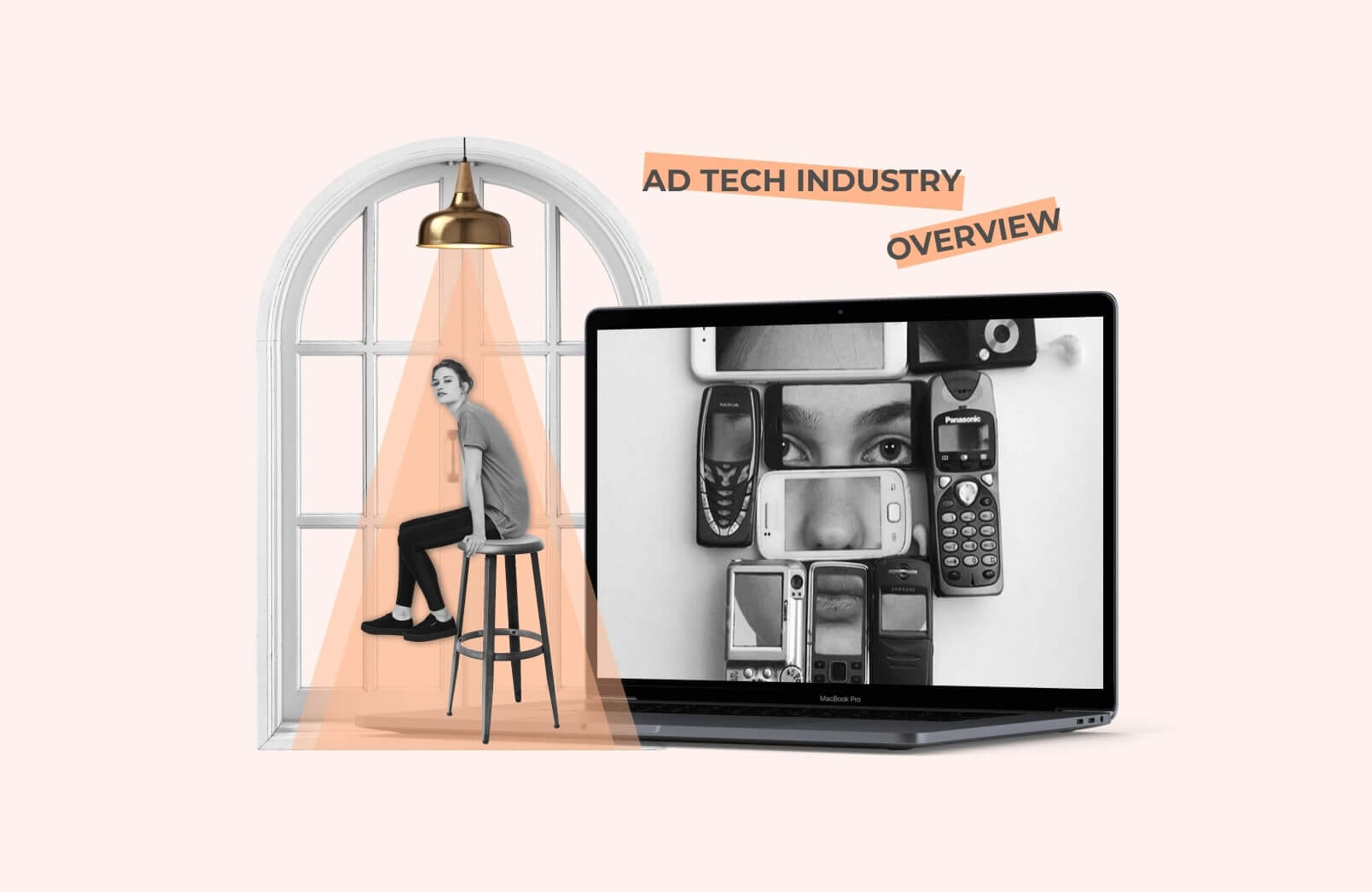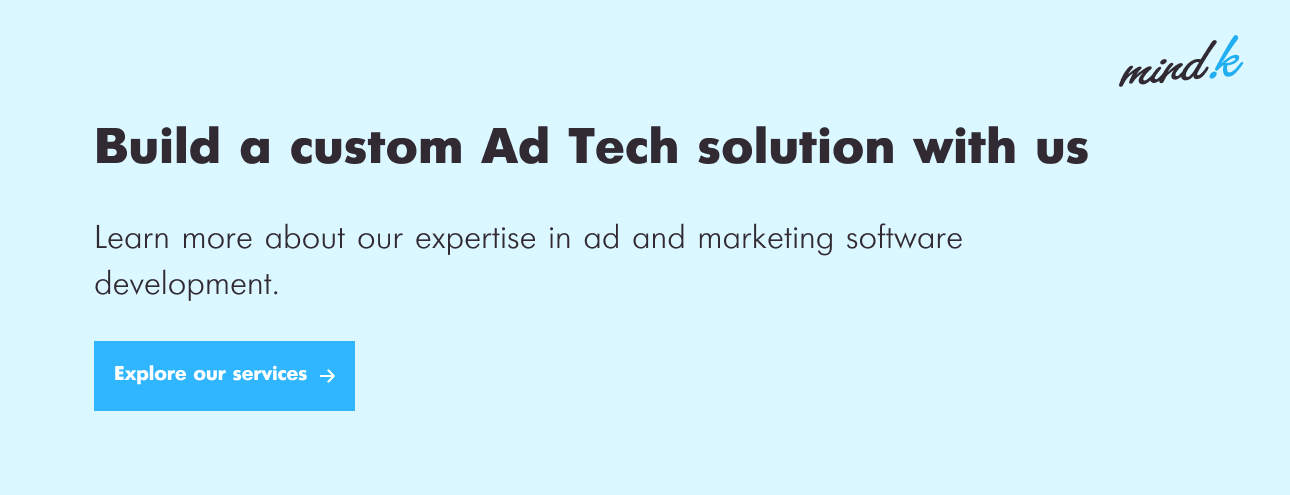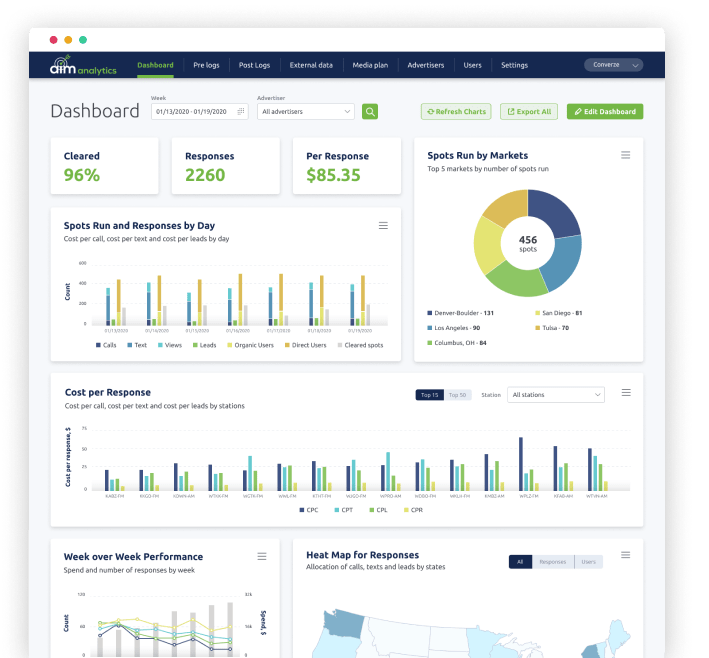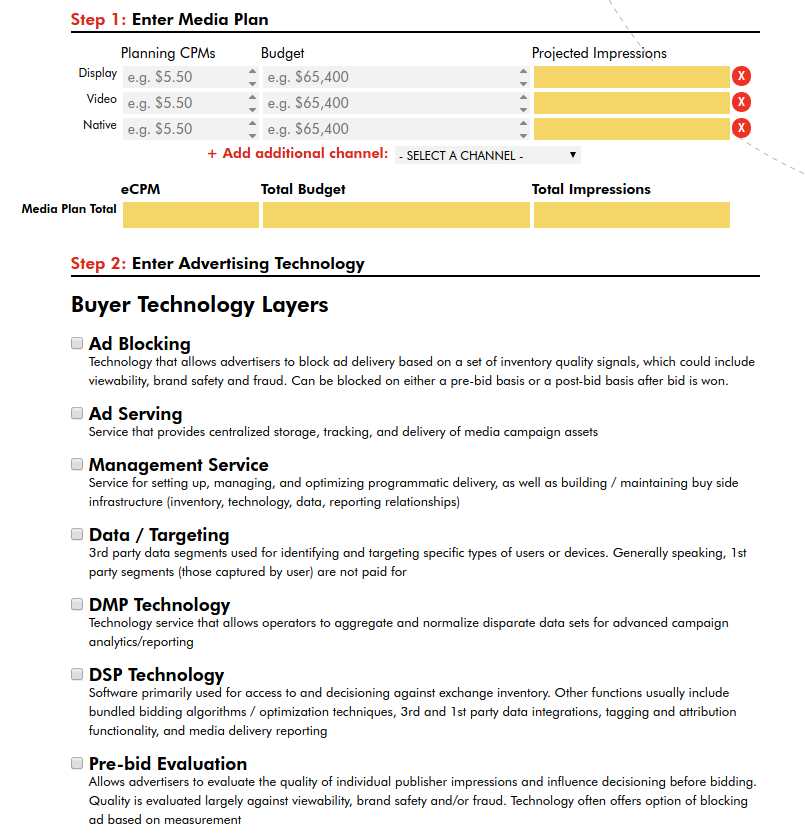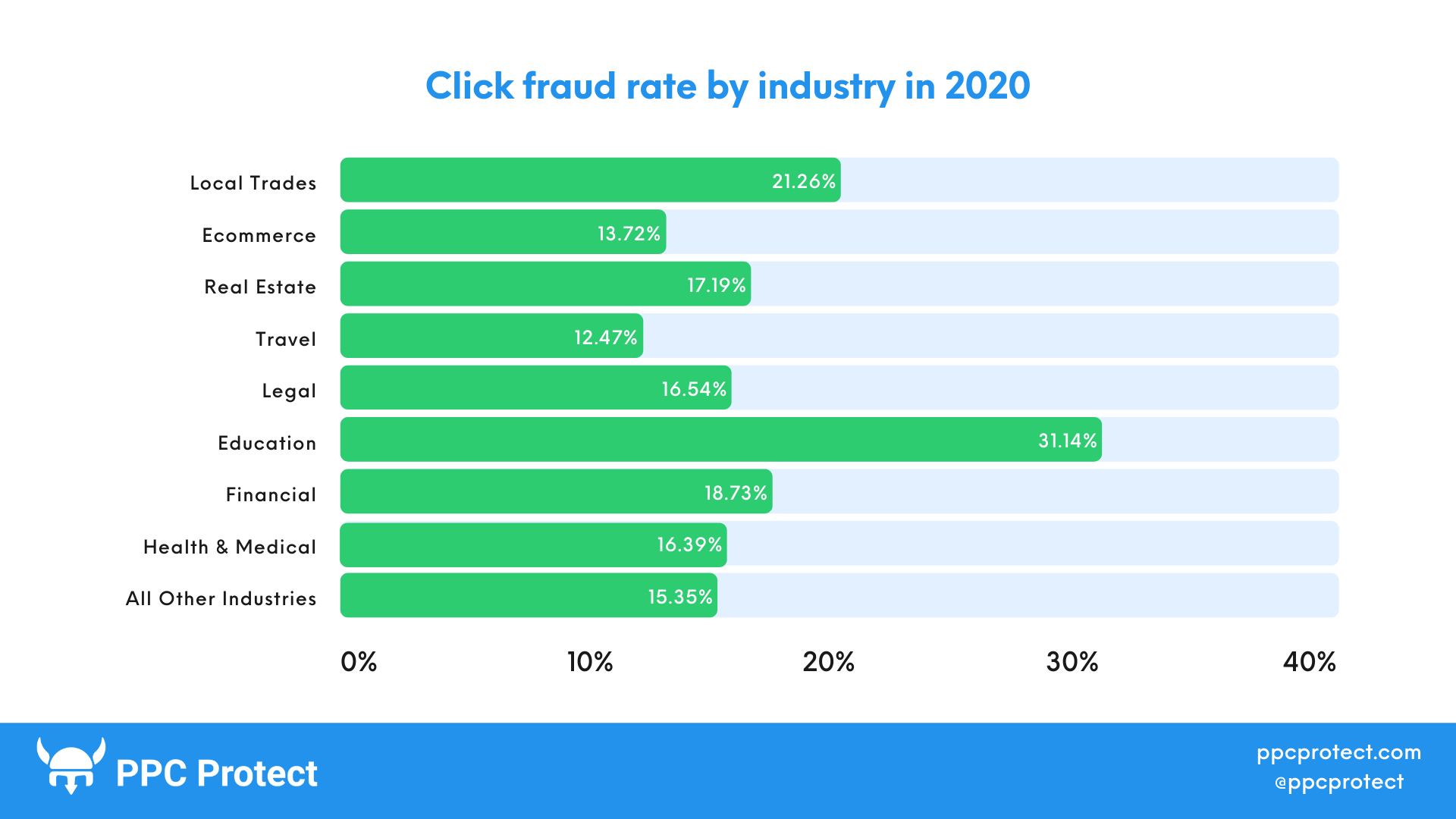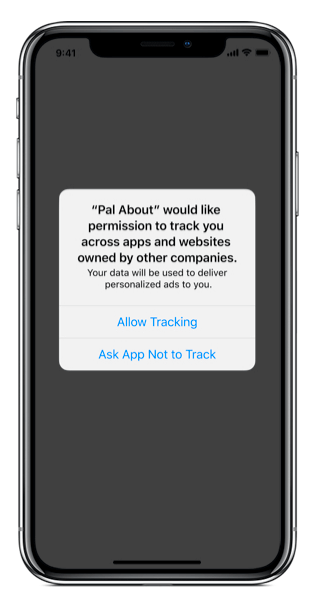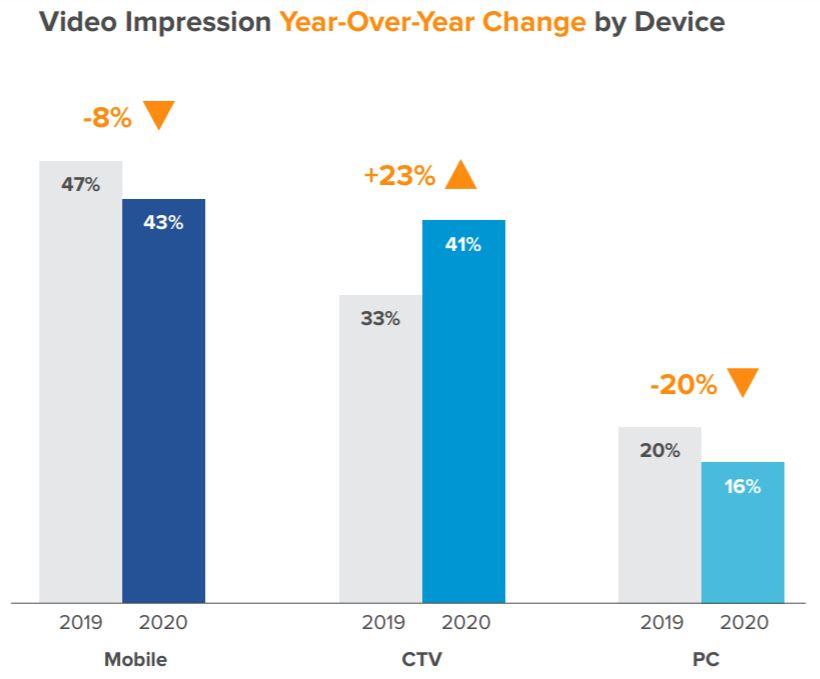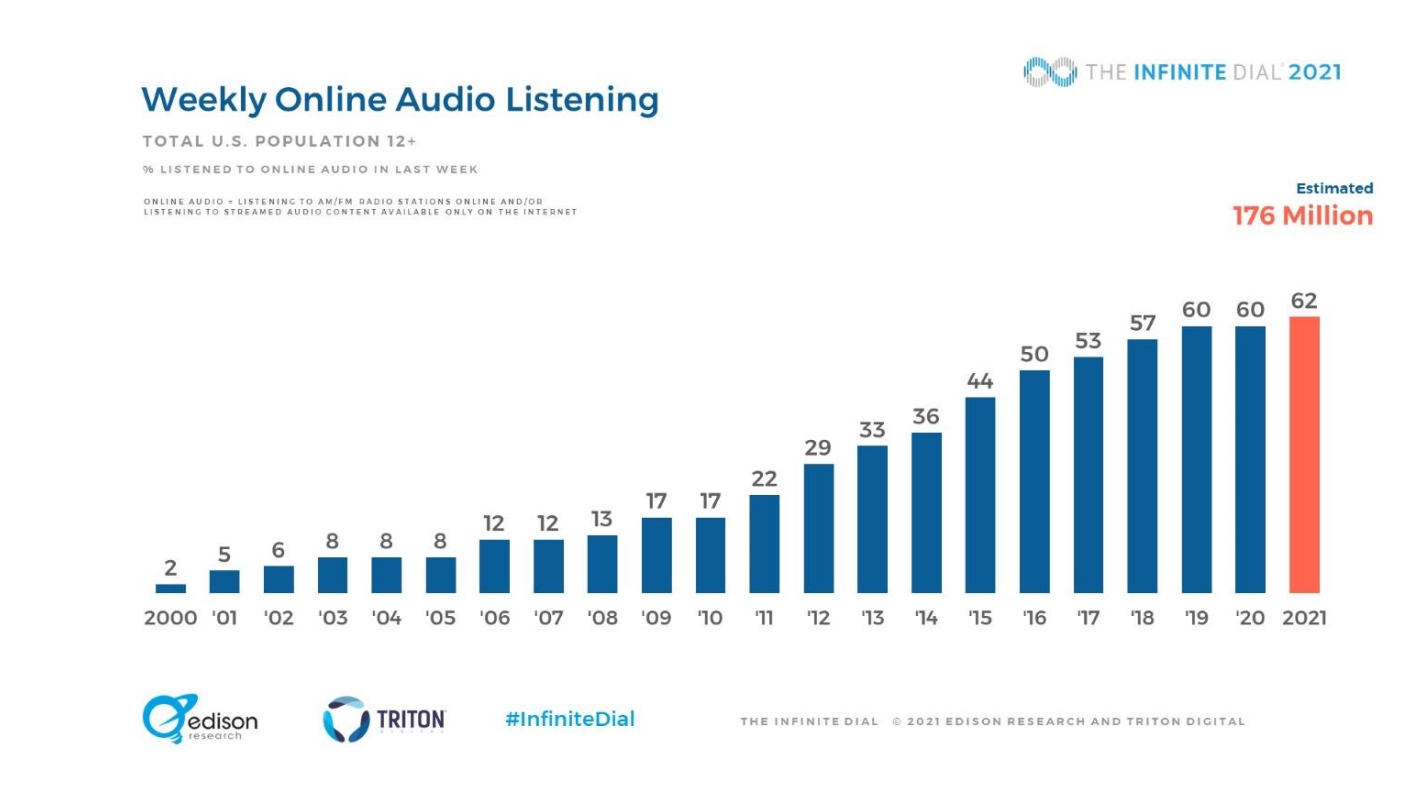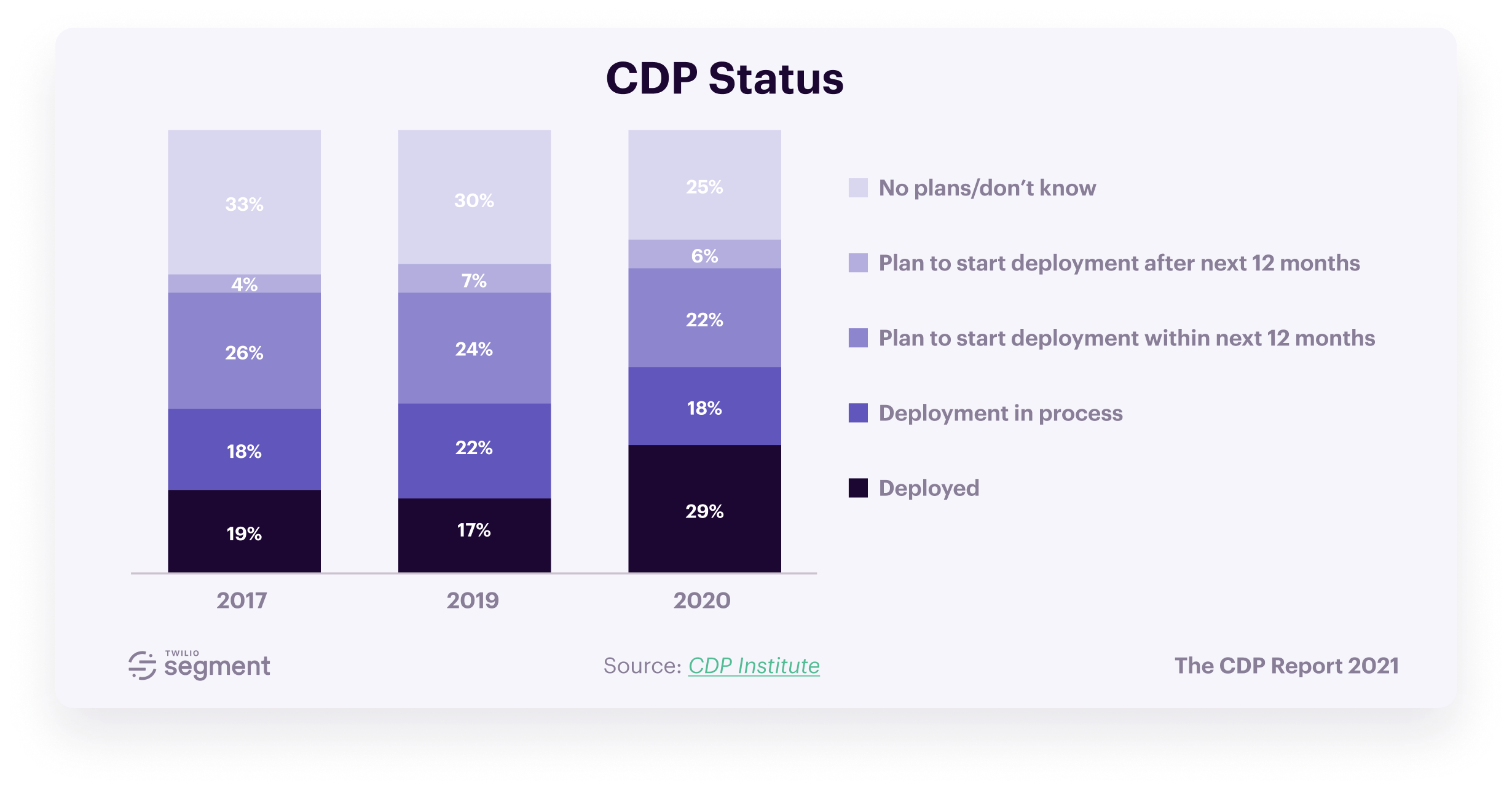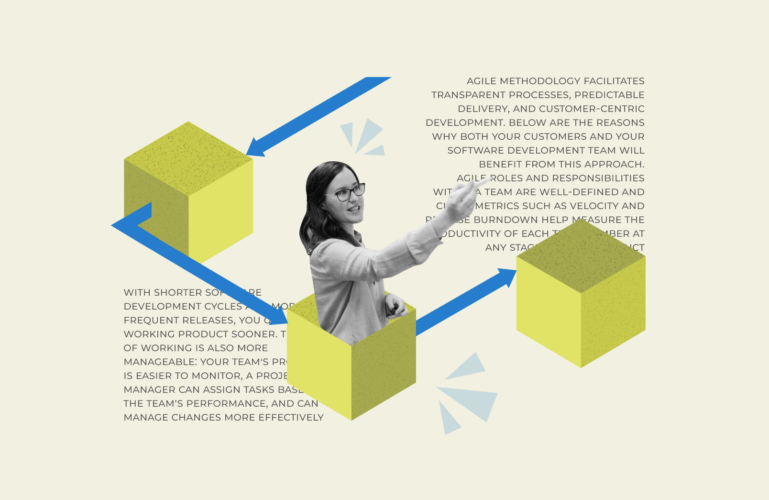The potential of the advertising market is huge. Total spendings on advertising are expected to reach $630 billion by 2024. Although being successful in advertising is no longer possible without technologies (advertising technologies).
The spendings on digital advertising grew up to 12% in 2020 despite the pandemic. This is not surprising. Would such giants like Facebook or Google be able to reap 10-figure profits without tailor-made ad technology? Or would millions of brands manage to bring their product or service to the people without using ad software to some extent? Very unlikely.
Here at MindK, we’ve been developing digital products for marketing and advertising for years and can state that the key to success in the advertising industry today is simple – not to miss the latest technology trends and adapt them to your own business needs. But the key problem here is that the AdTech market is rather complex, thus, misunderstood. Our goal here is to help you understand this industry, so you can confidently invest in it.
So, what is Ad Tech, and what’s it for?
Advertising technology (or simply Ad Tech) is a generic term that includes all kinds of digital solutions that collect and process data to form, control, and analyze advertising campaigns.
Ad Tech is very often confused with marketing technologies (Mar Tech). Although these concepts intersect, they are not the same thing. Mar Tech involves a range of software that helps to achieve marketing goals, while Ad Tech refers to different types of analytics and digital tools used in the context of advertising. In general, we can say that Mar Tech is the “mother” of Ad Tech.
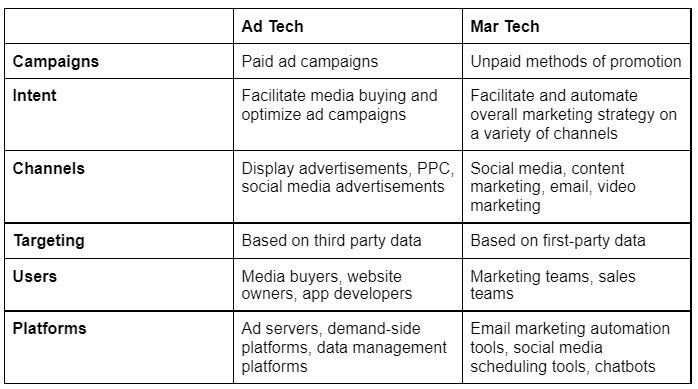
So, why is Ad Tech in the spotlight now? The time when an advertisement was shown to a maximum number of people using as many ad channels as possible is a thing of the past. This strategy, however, doesn’t allow finding a personalized approach to people and establishing a real connection with potential clients. As a result, the effectiveness of such a strategy is low, compared to its high costs.
Advertising technology, on the contrary, is focused on increasing the effectiveness of advertising channels. Using advertising technologies, advertisers collect massive amounts of audience data and determine the target audience more accurately.
Ads are delivered to the most relevant audience at the right time and the right place. Moreover, Ad Tech allows analyzing the results of ad campaigns to further improve their effectiveness. Everybody wins – advertising technologies save advertisers time and money, publishers can monetize their digital assets, and users get the most useful and relevant offers.
Let’s take some examples. The set of Amazon advertising solutions in 2020 brought the company around $21.5 billion compared to $9.3 billion in the year before. For such giants like Google and Facebook, their revenue also depends on advertising. Last year, for instance, Facebook received 97.9% of its revenue from advertising, while Google around 75%.
In general, advertising technologies are designed to meet these main goals:
- help advertisers and ad agencies create, customize, measure, and manage ad campaigns to get maximum return on investment (ROI);
- help publishers and ad space owners sell the ads at the best price;
- simplify the process of matching advertiser demand and publisher supply across ad networks.
At MindK we help our clients develop Ad Tech products that solve these objectives. For example, we developed an intelligent solution for one of the leading direct-response advertising agencies in the United States, Converze Media Group. The main objectives of our client were to automate end-to-end advertising workflow, and allow managing and analyzing thousands of different radio and TV advertising campaigns in a few clicks.
Aim Analytics developed by the MindK team gives a birds-eye view on ads analytics that allows our client to come up with winning ad strategies again and again
All of these goals we mentioned above fuel the development of the Ad Tech ecosystem. But how exactly does this ecosystem operate?
Ad Tech industry analysis: what does the ecosystem look like?
The Ad Tech ecosystem is rather complicated and involves a number of participants, namely, companies and platforms which create a loop of ad supply and ad demand. Here are the key participants of the Ad Tech ecosystem:
- Advertisers are companies trying to reach potential clients of their product or service on computers, smartphones, and other devices. In most cases, advertisers are brands ranging from global Fortune 500 companies to some niche or local-based organizations. They create the demand on the Ad Tech market.
- Publishers are companies that help advertisers deliver messages in front of the right audience at the right time at the best possible price. Publishers use data, algorithms, and computer science to create, target, and deliver ads with incredible speed and precision. Publishers form the supply on the market.
- Media agencies are the intermediary between advertisers and publishers. They help advertisers to create, plan and handle advertising campaigns, as well as to allocate ad budgets across multiple channels.
- Supply-side platforms or sell-side platform (SSP) allows publishers and digital media owners to control and manage their ad inventory. This platform gives a possibility to publishers to sell their impressions (meaning ad view or display) to specifically targeted buyers at the maximum price.
- Demand-side platforms (DSP) are independent platforms that help advertisers and media agencies buy and manage ad inventories from different ad sources in a single place. DSP doesn’t own or buy ads directly from publishers, however, they communicate with a supply-side platform (SSP) through an ad exchange (we’ll review this term below).
DSPs can be also used for real-time bidding (RTB) that allows advertisers and media agencies to buy ads on a per-impression basis. At a high level, RTB means that at any moment different advertisers can bid on a single impression.
Let’s take for example – watching the ad when playing a mobile game. At that moment, by means of a mobile software development kit (SDK), there is an auction between advertisers interested in that particular user. The advertisers make a bid and the supply-side platform selects the highest. RTB parameters like minimum and maximum bids or prices can be set up both by publishers and advertisers.

Source: investors.fyber.com
- Ad exchange platform is a middle link between DSPs and SSPs in the RTB process. As a rule, they are used by large Ad Tech organizations. The most illustrative examples of ad exchange platforms are DoubleClick Ad Exchange by Google, OpenX, Microsoft Advertising Exchange, AppNexus, Right Media Exchange by Yahoo, and so on.
- Ad network is an ad service provider that usually has proprietary technology and helps advertisers run ad campaigns across various sources of online inventory. You can think of Ad networks as the real estate agents in the world of digital advertisement. Large publishers usually use ad networks to sell their unsold ad inventors, while smaller ones might sell the better part of their inventory by means of networks.
- Ad server is the platform that makes instant decisions about what ads will be displayed at what time and on what device. Ad servers also collect data about ad performance and provide in-depth analytics. There are two main types of ad servers: sell-side (or publisher-side) and buy-side (or advertiser-side). Both of them involve the same technology, however, the use cases are different.

Source: kevel.co
- Data Management Platform (DMP) allows understanding the target audience behavior. They allow collecting user data from different sources like cookies, Application Programming Interfaces (APIs), tags on the websites or in mobile apps, and so on.
The ecosystem may look a bit overwhelming, however, if you see the big picture of how all the participants interact, you’ll understand how smooth the advertising process is. Here is an illustrative example:
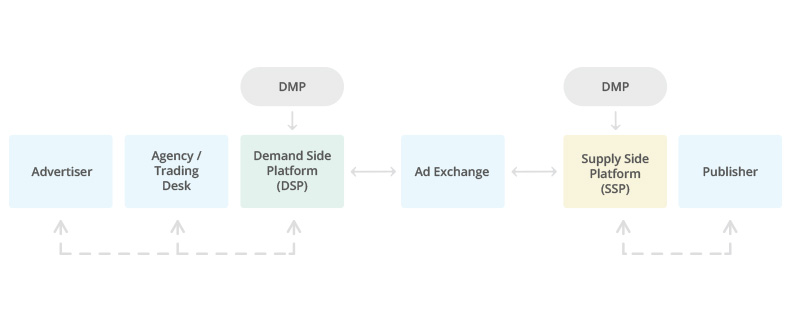
Source: medium.com
To make things more clear, let’s see how Google’s Ad ecosystem works. Let’s say a clothing brand needs to advertise its new collection, the brand hires a media agency. The media agency pushes the advertising to the ad ecosystem. The ad goes to the ad server, in our case, it is Google Campaign Manager (it competes with Innovid, Sizmek by Amazon, and others) until both advertisers and publishers agree on price and placement. The advertiser uses DSP Google Display & Video 360 to check the available ad spaces. Publishers upload available ad space so the clothing brand can bid on it. After the sides agree on terms, the ad server sends the ad to the publisher’s website and users see it.
How Google’s ad ecosystem works
Source: bloomberg.com
The Ad Tech ecosystem is pretty young and is developing by leaps and bounds. This development is highly affected by ongoing changes in business and technological environments. Some of these changes represent certain challenges to the advertisement market, while others – give plenty of new opportunities. However, what challenges and opportunities should a person be aware of when entering this industry? Here are some of them.
Major Ad Tech industry challenges companies are facing right now
Challenge #1. Blocking of third-party cookies
Internet browser developers are one by one blocking third-party cookies that presents a certain challenge for digital advertising and online marketing. Cookies allow to track the activity of users on the web and enable digital publishers to target advertising. Today, up to 50% of Internet traffic is tracked through third-party cookies.
In addition to advertising, key analytical tools such as Google Analytics or Hotjar are based on cookies. Disabling analytic cookies by default will also make it much more difficult to track traffic.
The decision to block one of the most powerful online tracking tools is pretty clear. Over the past years, there has been constant pressure on the Ad Tech and online marketing industry due to the fact that cookies help create a profile of Internet users based on hundreds of attributes. Further, this information is sold to everyone who needs it. Quite often the user doesn’t know about it and doesn’t give their consent.
Browsers like Safari, Firefox have already blocked third-party cookies by default to prevent tracking. In addition last year Google also announced that they plan to block third-party cookies in Chrome until 2022, but later delayed this plan to 2023. As long as Chrome remains the most popular browser with a market share of 64%, this decision will have a huge impact on the ad industry.
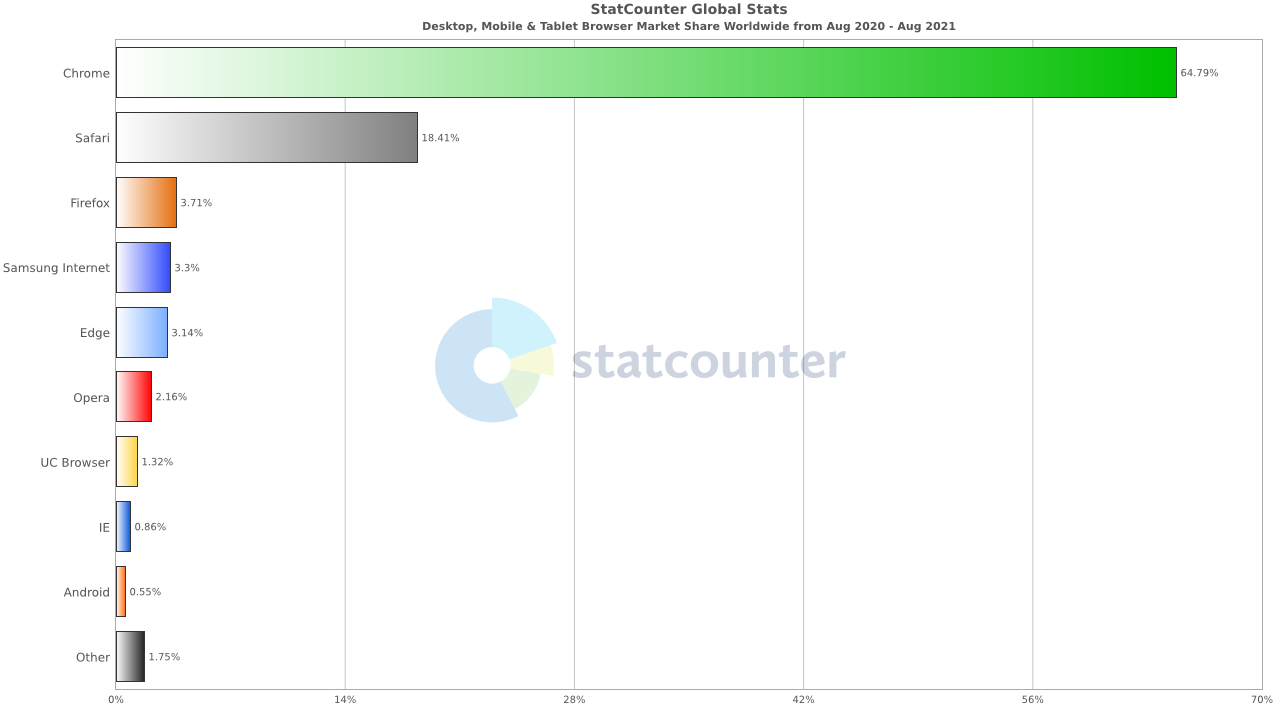
Google promises to publish a more accurate timeline of changes on the Privacy Sandbox website. However, for today there is a preliminary plan which should be approved by regulatory authorities so far. This plan involves a two-step process:
- Phase One (starting at the end of 2022): publishers and the ad industry will be provided with the time and tools they need to adapt to change. Google estimates this phase will take around nine months during which the company promises to keep a close eye on the progress and provide proper support.
- Phase Two (mid-2023): Chrome will end up supporting third-party cookies within three months ending at the end of 2023.
A lot of companies are now working on solutions that can become an alternative to third-party cookies. For example, BritePool and NetID are developing user tracking through encrypted email addresses instead of cookies.
Challenge #2 Lack of ad cost transparency
The challenge with transparency in Ad Tech is not new, it has been a hot topic for many years. However, the challenge still exists in 2021. Transparency in advertising technology is important because of two main reasons: cost and inventory.
The advertiser should have a clear picture of where the ad is placed and wherein the ad tech chain the money is spent. Lack of this information makes the media budget uncontrolled and prevents a company from making well-grounded decisions.
Many companies are working on solutions to make programmatic advertising more transparent for all the parties involved. Interactive Advertising Bureau (IAB) even implemented a Programmatic Fee Transparency Calculator to help advertisers evaluate programmatic technology, services, and inventory costs.
The IAB’s calculator enables estimating the real cost of media campaigns
Source: iab.com
Here at MindK, we also help our clients overcome this problem with technology. Namely, on one of the projects we developed an intelligent system to make the process of analyzing ad results (logs) more transparent and analyzable. Here is a short overview of the project:

Challenge #3 Ad fraud
Alongside the lack of cost transparency, the Ad Tech industry also struggles with bad quality of advertising or ad fraud. Ad fraud is the fakery with a number of clicks or impressions with a digital advertisement that usually involves bot traffic and fake clicks.
The Global PPC Click Fraud Report 2020-21 shows an increase in click fraud in 2020. It refers to all types of ad formats and to almost all industries.
As a result, advertising fraud caused $35 billion in losses worldwide in 2020. This, by the way, represents 10% of the global digital ad market size. All this makes ad fraud one of the most expensive problems for advertising.
To fight this challenge, Ad Tech companies are forced to apply various ad fraud detection and prevention techniques or work with a technology provider which can help accurately reveal the bot traffic and other types of fraud and take actions.
However, as every challenge is an opportunity, the ad fraud issue gave rise to companies focused on developing solutions to help advertisers deal with fraud. For example, ADEX, a fraud detection tool, uses artificial intelligence to detect and block invalid traffic and provides real-time reporting to analyze the advertising traffic quality.
Real-time reporting by Adex
Source: adex.com
Other challenges in Ad Tech worth considering
Sure, the above-mentioned challenges are not the only problems that throw sand in the wheels of the Ad Tech industry. There are a number of others that you should know, among them are:
- Apple’s privacy changes in iOS 14 that refers to direct user consent to use the unique Identifier for Advertisers (IDFA) of their device for tracking and sharing this data with other companies to improve advertising. iOS 15 plans to keep on improving the privacy features.
A pop-up that appears when the user opens an app that wants to track user activity
- Upcoming changes to Android refers to the fact that Google plans to make some changes to its Android Advertising ID (AAID), also known as the Google Advertising ID (GAID). The changes include the ability to blank the advertising ID of the device, and a new safety section for all the apps on Google Play.
- Ad “blindness” which deals with using ad-blocking tools and low clickthrough rate (or CTR). The latest report on ad blocker usage shows that around 42% of users in the world are using ad-blocking tools at least once a month. The main reasons for this are the excessive amount of ads or ads which are irrelevant and annoying.
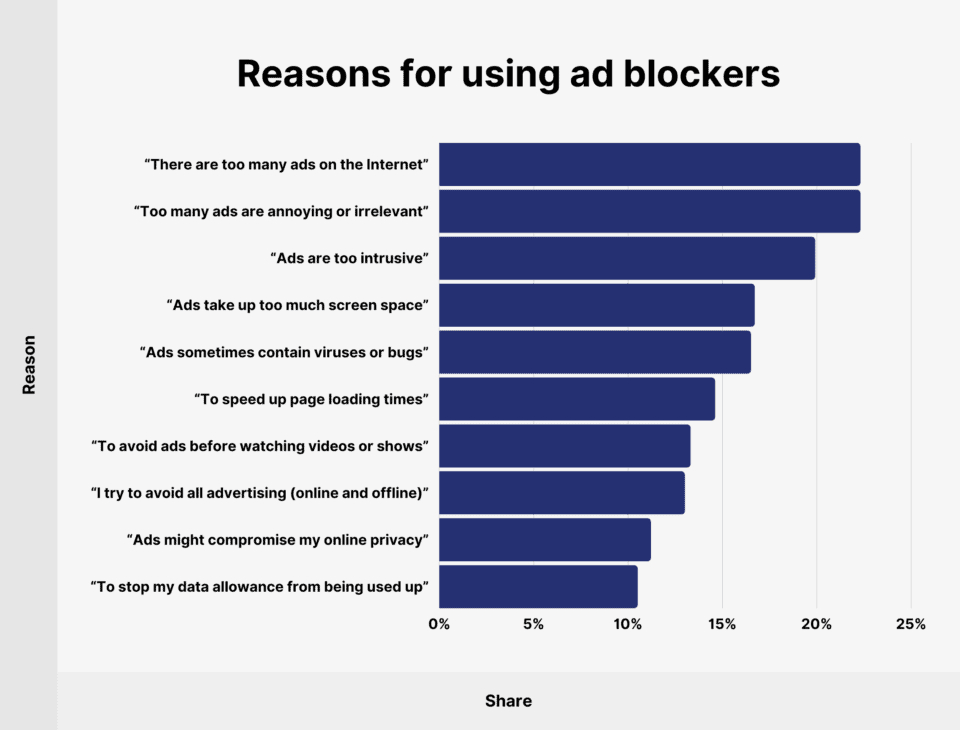
In the first quarter of 2020, the average CTR for advertisements on Google Search dropped from 2.5% to 1.55% and is remaining low. The ad CTRs also decreased on Facebook, Instagram, Linkedin, Twitter. That is why low CTR and using ad-blocking tools is now a huge challenge for Ad Tech companies that will need to come up with new engaging formats for ads, using native advertising techniques, and so forth.

- Governmental laws and regulations like the General Data Protection Regulation (GDPR) in Europe, Consumer Privacy Act (CCPA) in California, ePrivacy Regulation in Germany, and other laws and regulations in different countries that influence using data and advertising business.
To sum up, the Ad Tech industry like any other industry on the planet has certain challenges to fight with. However, being a very dynamically developing sector, Ad Tech presents enormous opportunities. We’ve singled out some Ad Tech industry trends and opportunities that may be attractive for startups.
Forward-looking opportunities for Ad Tech startups
Keep up with the rise of CTV and OTT platforms
There is now a hype around the connected TV (CTV) and over-the-top (OTT) platforms. OTT platforms provide media services like television and film content via the Internet (like Netflix, Hulu, HBO Now, Amazon Prime, and similar), while CTV is a device that connects the television to stream the video content.
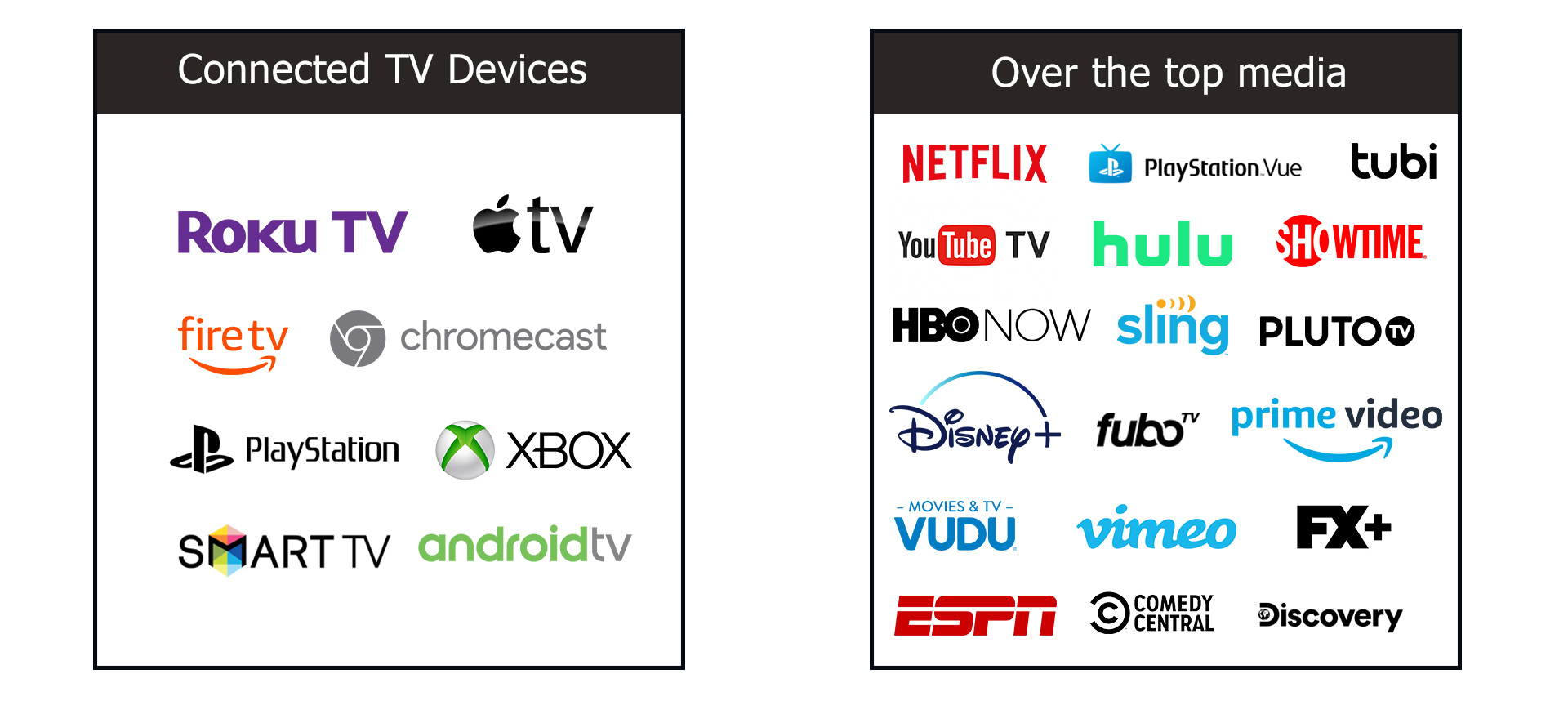
This trend presents a huge opportunity for advertising technology because with the pandemic most people shifted their attention from social media channels to OTT platforms. The statistics show that an average consumer is subscribed to at least four streaming services.
There is no surprise why digital advertising saw an increase in CTV ad impressions in 2020. Amidst the decrease of ad impressions on mobile and desktop, the increase of 23% on CTV looks very promising.
Source: tvtechnology.com
There are a number of challenges inside this trend that represent opportunities for Ad Tech digital solutions. Among these challenges are:
- fragmentation of CTV devices;
- identifying audiences among the huge CTV and OTT environments;
measuring the viewability and performance of ads inside the ecosystem; - ad fraud, and others.
Focus on transparency-oriented solutions
As we’ve already mentioned, transparency is a long-lived challenge in the Ad Tech industry, so solving this is a real need of the market.
Marketers want to know where their ads are placed. They want to know which ad works and how much revenue each investment generates. Users wish to know how their personal data is used. Publishers strive to understand how the audience interacts with ads on their websites, and how much revenue is actually generated for partners.
In other words, everyone needs transparency. As big tech players continue to raise higher barriers, it becomes more difficult to dive into the details of how advertising technology works.
Use AI and ML to optimize, place and analyze digital ads
Artificial intelligence (AI) remains among the top-ranking technologies that will develop in the near future. The application of both AI and machine learning (ML) has all the power to influence further innovations in the Ad Tech sector.
For example, Getintent uses predictive technology, focused only on effective ad impressions: algorithms analyze data and calculate how the user will react to it.
Another important topic for all advertisers is targeting, and AI can also help here. Quantcast, an AI-driven targeting and measurement solution allows improving conversion by better targeting. The client can share characteristics of their ideal audience and Quantcast will use hundreds of data available to build a custom model to improve targeting.
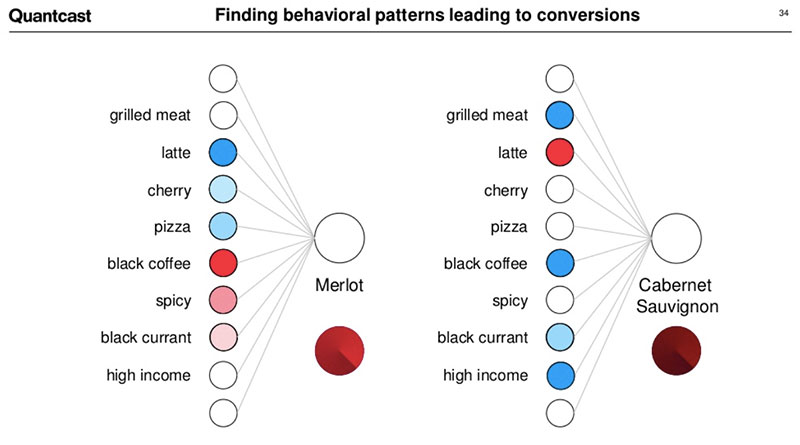
Source: topbots.com
Evaluate the role of audio and voice technology in advertising
Digital audio content is embedded in our everyday lives and is giving rise to voice audio advertising. Google has already announced new audio advertising options which are focused on helping companies connect with the popularity of podcasts, digital radio, and other digital audio forms. Just think, 62% of the US population over 12 years are weekly listeners of online audio content.
In light of this, in the near future, we can expect the evolution of platforms focused on online audio ads with new unique targeting, personalization, and analyzing techniques.
Make a point of native advertising
Users become less open to any kind of interruption while consuming the content. Above in this article, we’ve already seen the statistics of using ad blockers and the main reasons for this. That is why Ad Tech companies should try to focus on the ways to natively embed advertisements in the content, video, or even games in the best possible way.
For example, startup Anzu.io creates advertising effects in games and applies dynamic banners to different objects, while Adverty‘s solution can natively integrate ads even into AR/VR games.

Source: anzu.io
Automate ad personalization and creatives
60% of marketers consider personalization a key strategy for improving the marketing campaign results. Very often it is not enough to have one or two versions of ad creative (creative may involve images, videos, audio, and other formats) in order to be successful with a digital ad campaign. At the same time creating dozens of ad creative variants is very costly and time-consuming.
That’s why more advertisers are examining solutions that enable making dynamic creatives. Dynamic creative, also called dynamic ad, is a programmatic advertising method when the advertisement message updates in real-time according to certain parameters predefined by the advertiser. Take, for example, Hunch, a creative automation platform that enables dynamic creative video and image production on Facebook and Instagram.

Source: hunchads.com
Take a fresh look at data
In view of all the above-mentioned challenges concerning user data privacy including blocking third-party cookies, changes made by Apple and Google, laws and regulations like GDPR, ad targeting capabilities will continue to decline. That is why working on new types of targeting and user identity is becoming a priority for many Ad Tech companies and startups.
It is important to know that users are now able to switch over to a new level of interaction with brands by sharing their data. What is meant here is zero-party data – data that users intentionally share with advertisers. This data provides advertisers with precise parameters of users’ purchase intent and interests.
Advertisers now more often refer to the term Customer Data Platform (CDP) which is a marketing platform for working with user data. It brings together all available data sources and creates a single user profile. This data can be used to target any communication channel, as well as for end-to-end analytics.
In 2020 there was a sizable increase in CDP adoption compared to recent years. One of the reasons is the big increase in the volume and variety of different data being tracked. The report shows that around 47% of people state they plan to grow their CDP budget by more than 25% in the next 5 years.
In light of this, a completely new approach to gathering data for digital advertising may give Ad Tech startups a wellhead of opportunities for new innovative ad solutions.
Develop your Ad Tech solution with MindK
The AdTech market is constantly evolving, and the interest in technological solutions from all the participants of the ad market will definitely keep on increasing in the future. So, if you have an Ad Tech idea that waits until you bring it to life, now is the better time to do it.
MindK has experience in developing software for marketing and advertising. Our team can help you build a powerful Ad Tech solution that will process millions of data points, integrate with ad campaign management tools, provide the best return on your client’s ad spend and solve other challenges of the market. To find more about our expertise, check our Ad Software development services and case studies.
